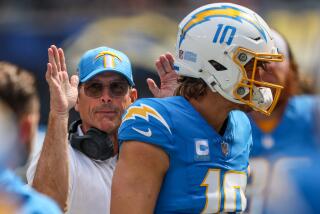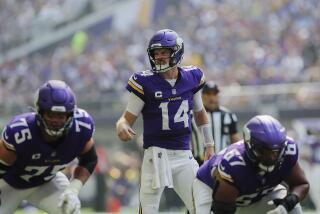Best QBs Have Tools, and Right Mind-Set
The world turns out scores of terrific neurosurgeons, preeminent physicists, boffo biologists and venerated men of letters--arguably even a few top-drawer sportswriters.
So why are there only five great quarterbacks?
Bill Walsh conducts camps for them, Sid Gillman still breaks down film of them, networks pay billions to televise them.
Kids have played the game on sandlots for years and not one yet has volunteered to play center. Any boy worth his football salt wants to throw the rock, throw it hard, throw it through an old tire, throw it with a spiral so tight he can hear the ball hiss.
Yet, we count the difference makers on one hand:
1. Brett Favre, Green Bay Packers. Simply, the best quarterback in the game.
2. John Elway, Denver Broncos. Heâs 37, but still a prime rib cut above.
3. Steve Young, San Francisco 49ers. A step slower at 36, but still a supernova.
4. Troy Aikman, Dallas Cowboys. Won three Super Bowls, one with Barry Switzer as his coach.
5. Dan Marino, Miami Dolphins. Not what he used to be, but just remember what he used to be.
You could argue for Drew Bledsoe, Mark Brunell, Kordell Stewart and the raging, if not aging, Warren Moon, but you would be mistaken.
Frankly, this quarterback shortage is worrisome.
Once, there was the NFL class of 1983, a mother lode that yielded Elway, Marino, Jim Kelly and significant others. But greatness since has been dispensed in drips and drops. The class of 1984 sent along Young. Aikman was dropped off in 1989, Favre in 1991.
And not a single, solitary, slinginâ Sammy superstar has appeared since.
The NFL, of course, is thrilled this year to be getting Tennesseeâs Peyton Manning and Washington Stateâs Ryan Leaf, probably the best 1-2 quarterback punch in years.
What took so long?
The folks responsible for producing great NFL quarterbacks are college coaches, of course, so we asked five to explain why they havenât been able to keep up with demand.
The consensus: The game is evolving at warp speed. Players are bigger, faster, stronger and smarter than ever, and a lot more of them now play defense. And defenses tend to be disguised by complicated formations.
Football has become a cat-and-mouse game of Darwinism between offense and defense, thus, âsuperstar quarterbackâ has made the endangered species list.
Finding a quarterback who can stand tall in the pocket, run if he has to, unravel the mysteries of zone versus man-to-man coverage in the time it takes to say âOne-Mississippi, two-Mississippi,â and throw a 20-yard out pattern on a line, is akin to striking oil.
In 30 years, football has gone from a 45-rpm record to a laser disc.
âIf it came down to one word, it would be âspeed,â â says Purdue Coach Joe Tiller who, with great success, introduced wide-open offense to the Big Ten last season. âThe precision demanded at the position today is greater than itâs ever been. It takes a greater talent at the quarterback position to stand out than it used to take.â
As coach at Wyoming, Tiller had an epiphany while watching a 1990 Brigham Young-Miami encounter in which BYU quarterback Ty Detmer, a future Heisman Trophy winner, tried to punch holes in a lightning-fast Miami secondary.
âI made a comment to our coaches, I said, âThat Miami defense makes the field look smaller than what it really is. They just close on the ball so much quicker.â â
Clearly, todayâs quarterbacks suffer responsibility overload.
They must be tall--although how tall is debatable--6 feet 4 or more is preferable.
They must be durable, able to avoid tall buildings (defensive ends) and 245-pound blitzing linebackers.
They must be leaders, cut-throat competitors, sound of body and mind. They must excel under intense pressure and increased scrutiny.
They must make split-second decisions.
âYou canât be one-dimensional anymore,â says Washington State Coach Mike Price, who coached Bledsoe and Leaf. âYou canât be Doug Flutie and sprint out every time. You canât just be some rawboned guy that stands in the pocket. Itâs a real difficult position to play. A receiver is going to be open, but youâve got to find him and you have two seconds to do it. If youâre not right on the top of your game intellectually, then youâre going to get sacked.â
Itâs no wonder football watchers are salivating over Leaf, a 6-6, 240-pound quarterback with a rifle arm, canned hams for calves, great football instincts and a thirst for knowledge.
âIf you put it on a chart, youâd have to say Ryan Leaf indicates the future of the position,â University of Arizona offensive coordinator Homer Smith says.
Bill Diedrick, who coaches the University of Washington quarterbacks, is polishing his own diamond in Brock Huard, a top NFL prospect who recently decided to return for his junior season.
Before moving to Seattle, Diedrick coached Bledsoe while an assistant on Priceâs staff.
Diedrick says the bar for quarterbacks is constantly being raised. He says great quarterbacks must stand out on three levels--mental, physical and emotional. To be a superstar, Diedrick says, âit takes a high percentage in each one of those categories.â
The difference between great and good quarterback may seem negligible, until a game needs to be won.
âWhatâs the difference between Trent Dilfer and John Elway?â Diedrick asks. âJohn is the total package. And you look a Trent, well, Trent is not the total package. Itâs like being an artist and painting a picture with all the colors instead of three or four. You can still paint the same picture with five or six colors, but think of the beauty when you blend all the colors.â
Smith, the former UCLA offensive coordinator and long regarded as one of the college gameâs most acute offensive minds, says great quarterbacks are simply getting harder to find.
âThereâs a lot of space between the good ones and the poor ones out on the edge,â he says.
What ultimately separates great from good?
Intelligence, he says.
The game, coaches say, has changed most dramatically between the helmet holes.
âYouâve got to be able to think,â says Kentucky Coach Hal Mumme, who burst onto the Division I coaching scene last fall by transforming the moribund Wildcats into the nationâs No. 2 passing team. âThatâs not probably, that is the first thing we look at. After that, we look for character, leadership, an overhand release, good pocket, feet and vision. To learn our system takes a little training. We donât want to train a guy for two years and have him flunk out on us.â
Mumme, who developed bell-ringing offenses at Division II Valdosta State before taking over in Lexington, was lucky enough to inherit sophomore Tim Couch, who rewrote Kentucky record books in 1997 and returns next season as a leading Heisman Trophy candidate.
And although Couch has prototype size, 6-5, and arm strength, Mumme says what sets Couch part is his mind.
âTim is a rarity,â Mumme says.
âHow many high school prospects have the physical tools but not the mental?
âA ka-zillion,â he says. âWhen youâre looking for that needle in the haystack, you throw out a whole bunch of pieces of straw.â
All five coaches interviewed insist that their quarterback prospects pass intellectual muster before being considered.
âIf heâs not in the top of his class, I at least want him to be an overachiever in the classroom,â Mumme says. âI donât want to see a guy with a 1,000 on his SAT, but he failed algebra.â
Tiller draws plays on the chalkboard for recruits and then makes them reconstruct them from scratch.
âWeâll get him on the board and make him explain coverage to us,â Tiller says.
Diedrick uses videotape to achieve the same end, making a recruit dissect his own high school tape.
â âGive me an idea what youâre doing here,â â Diedrick will say. âI donât understand this pass route.â Itâs not like he has to be an A student, but heâd better have a great knowledge of the game.â
Diedrick has been fortunate with Huard, the son of a high school coach.
Bledsoeâs father is also a high school coach, which gave Drew a head start at Washington State.
Leaf, whose father is an insurance man, was farther behind.
âBledsoe came in more ready to play than Leaf,â Price says.
Was Price sure Leaf could absorb Priceâs offense?
âI didnât know right away,â Price says. âIt was something we worked on. We spent a lot of time watching film. Thatâs probably why we became so close. He had an insatiable appetite to learn.â
Why does a quarterback have to be smarter now?
âDefenses have changed,â Homer Smith explains. âThe patterns that once set records donât get you a pass completion today. Twenty years ago, you looked in a passing playbook and you had routes for the running backs, all these little flairs and swings, arrows and delays. Now, none of those routes get you open.â
So who are the next Elways and Favres and Marinos?
Manning and Leaf are the best hopes.
Huard and Couch are on the horizon.
Yet, Kentuckyâs Mumme says scouts are as much to blame for the NFLâs paucity of top-flight quarterbacks.
âThere are a lot of good college quarterbacks that never get to camp, because they donât meet the package,â Mumme says. âScouts come around and thereâs got to be a package. Theyâve got to be 6-4 and theyâve got to be 200-plus. A lot of them even have formulas. They tell you if heâs 6-4 he can run a 4.9 [40-yard dash]. If heâs 6-5 he can run a five-flat. Like that actually has something to do with quarterbacking.
âI tell them all the time, I say âYou guys would have turned down Bob Griese because he didnât pass the eyeball test.â â
More to Read
Go beyond the scoreboard
Get the latest on L.A.'s teams in the daily Sports Report newsletter.
You may occasionally receive promotional content from the Los Angeles Times.











